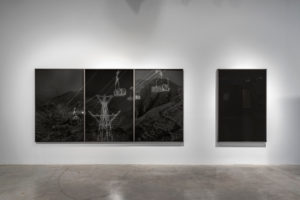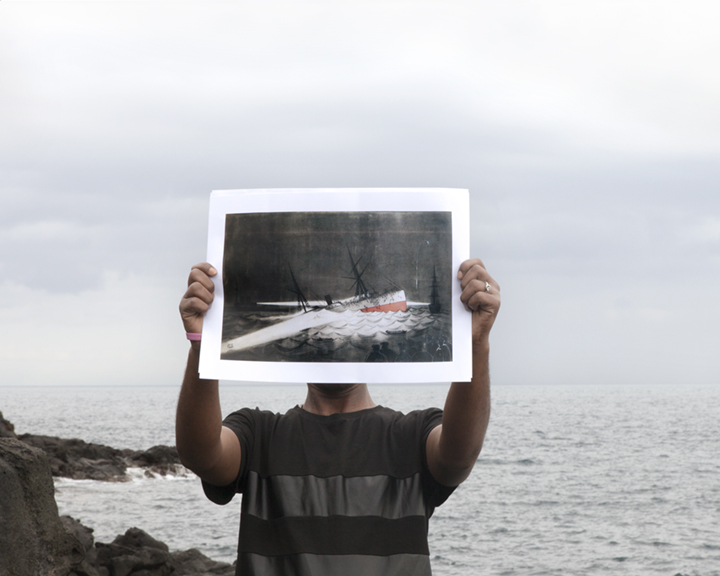It is important to discuss the issue as Italy represents the first arrival point for migrations from the African continent. Indeed, we witness feelings of cultural and racial superiority among Italians, rooted in the nation’s colonial past, wrongly perceived as short-lived and more humane and tolerant relative to those of other European nations.
Eritrean-born artist Dawit L. Petros has focused for over a decade on a critical re-reading of colonialism in North Africa. His artworks aim for an introspective and textured analysis of the historical factors that determined migrations, and his practice always includes extensive research on the field.
His concerns, expressed through his art, derive from lived experiences: Petros is the child of Eritrean emigrants, and spent formative years in Eritrea, Ethiopia, and Kenya before settling in central Canada.
He recently had an exhibition (still available for online tours) at the space “Power Plant” in Toronto. The show is called “Spazio Disponibile” (Available Space), and reflects on the lingering effects of colonial memory in Ethiopia and Eritrea.
The show is the culmination of Petros’ research for the project “The Stranger’s Notebook”. This was preceded by research he conducted in 2010 on Fesseha Giyorgis, a Abyssinian scholar, linguist, fluent in Arabic, French, Italian, and Tigrinya. Giyorgis lived and worked in Italy from 1890-1895 before producing the first secular text published in the Tigrinya language in Rome, 1895.

“The movements of this historical figure addressed the dynamic interplay between different cultures, and the relationship between modernism and colonialism,” explains Dawit. “I was motivated by the desire to know about Giyorgis’ period in Italy. The second factor was a desire to problematize the ‘European migration crisis’ narrative, which failed to meaningfully interrogate the complex political, historical and economic causes behind it.”
NM: The project “The Stranger’s Notebook” is very wide in scope, and includes the mobility within Africa and across the Mediterranean through architecture, industries and infrastructures. It also looks at questions of labour, the pitfalls of nationhood and intertwined narratives of migration. Did you have everything planned out from the beginning, or did it build up slowly as you worked on the project?
DLP: I did not have everything determined from the outset. The journey and the research conducted along the way were essential in shaping the project as it developed. I also needed a considerable period of reflection after the extensive period of movement, to understand what the work was.
NM: Did you physically travel to places, or was it more archival and virtual explorations?
DLP: The project combines physical travel with archival exploration. I have conducted extended field visits to the geographies under discussion: Eritrea, Italy, West and North Africa. This has meant time in migration centers, housing, spaces of socialization. It is essential that my body move across lands, airspaces and waterways in order to meaningfully understand the mechanisms that regulate the movement of people.
NM: Why is so important for you to be physically connected with the environment?
DLP: Physical presence matters. In a place like Italy the traces of imperial conquest are indelibly imprinted in public space such as street names, markers, squares and monuments. There are names that evoke former Italian colonial settlements and battle sites in Africa that nestle comfortably within the contemporary landscape. As an Eritrean, as a citizen of the former colony, my physical presence activates these displaced memories.
NM: For the show “Spazio Disponibile” you are employing wide archival materials collected over a period of seven years, what were your main sources, and was it difficult at all to access this material?
DLP: The historical research I undertake centers on the colonial records housed in the Archivio Storico del Ministero dell’Africa Italiana (Historical Archive of the Ministry of Italian Africa), the Archivio Centrale dello Stato (Central State Archives), Società Geografica Italiana (Geographical Society of Italy), Sapienza University of Rome, Pavoni Center in Asmara, and Northwestern University’s Melville J. Herskovits Library of African Studies. However, I am also invested in the accumulation of oral narratives of Eritreans and non-Eritreans in Africa, Europe and North America. The most difficult challenge is usually negotiating layers of bureaucracy necessary to do this type of research.
NM: Can you please tell us a bit about the biographical element that connects you personally with the themes explored in the show Spazio Disponibile?
DLP: I was born in Eritrea and spent my formative years in Ethiopia and Kenya before settling in central Canada. I have resided in the United States since 2004 and my research and work has taken me to numerous countries and continents. I decipher trajectories of displacement and reconfigure that information to reveal alternate understandings of social or cultural histories and to achieve a better understanding of my lived experiences.
NM: You had a newly commissioned film on Montreal’s Casa d’Italia, a community centre built in 1936. How did architectural language relate to fascist symbolism, in this instance and in colonial architecture?
DLP: The Casa d’Italia is a community space in Montreal, Canada that reflects the intersection of Italian Canadian migration stories with inter/national narratives because of the broader social forces that shaped both its construction and subsequent events.
Casa, Study 1 is a two-channel film installation in which a restless traveling Steadicam moves from the exterior spaces of the Casa d’Italia – the archive room, the hallways, auditorium, the mezzanine, and over a large marble stylized Fascist sun in a sequence of linked tracking shots.
A voiceover narration in Italian unfolds alongside the images, questioning how the Casa as a built form evidences traces of fascist building language and legacies of emigration and colonialism to the horn of Africa. The voiceover is Geometra Petros – a surveyor with extensive knowledge on Italian colonial architecture in Asmara, Eritrea. Petros analyses the syntax of the building: fasces on the façade, round shapes alluding to the fascio figure; oversized windows and doors; and a general penchant for mass and grandiosity – by comparing it to similar architectural structures in Eritrea. It isn’t until the very last frame that we learn that the subject whose provides the analysis in classical Italian is a subject of the former empire.
By rendering the aesthetic language of the Casa’s construction visible and connecting these to the historical conditions that produced them, it becomes the connective tissue linking Italian emigration, Italian colonialism in Africa and contemporary migration to Italy.
NM: Your focus is on the power of the object, that can communicate authoritarian and obscure ideologies, as well as connecting people across borders. How do these positive and negative aspects can coexist in the same object?
DLP: Spazio Disponible focuses on built environment and forms as contexts in which the operations of Italian coloniality are legible. These forms are metonyms that reflect the locations at which Italy’s empire intersected with spaces in East Africa
Spectre (La Teleferica) examines the complex history of the Teleferica which was the world’s longest cable car that connected the port city of Massawa to the Asmara, the capital city of Eritrea. In the monumental four-panel work, the networked landscape of colonial Eritrea is emblematized through inverted images of the metal frameworks that once supported the mobile cableway. The cable car here functions like a visual signifier that attests to how this technology re-ordered the physical landscape of Eritrea while helping produce modern Eritrean and Italian subjects.
NM: You also analyse the contemporary resurgence of nationalism in Italy and a suppressed colonial past. Can you tell us of the specific works that explore this link?
DLP: An idealized and assertive colonial memory is at work among the Italian public. This is accompanied with the rise of feelings of cultural and racial superiority that are adversely shaping the terms of encounter with disenfranchised subjects of the former Italian empire.
In a work called ‘Untitled (Overlapping and intertwined territories that fall from view III); Mokhtar, an asylum seeker from Eritrea in Catania, holds up an image that is a reproduction of an etching drawn by Georgina Smith, an eyewitness to the sinking of the transatlantic steamship SS Utopia. The vessel operated across various marine routes, and frequently transported European immigrants to the United States. In a tragic accident on March 17, 1891, the SS Utopia collided with a battleship and quickly sank off the shores of Gibraltar, killing over 500 passengers, many of whom were poor southern Italians seeking better lives across the Atlantic Ocean. Mokhtar’s gesture confronts the viewer with an artifact that conjures this historical event, acknowledging links between events across time and geographies. The displacement of Italian histories of emigration in which Italian’s themselves were the racial ‘other’ is surfaced.
Images courtesy of The Artist and Tiwani Contemporary, London

